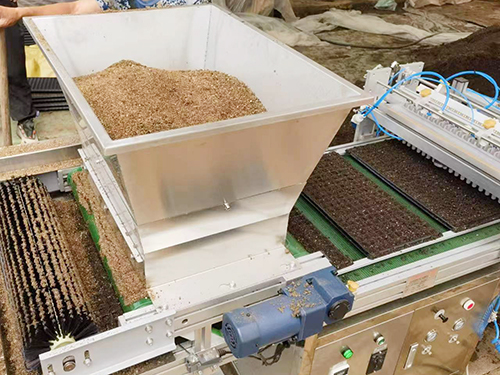How to Choose the Right Seedling Tray Seeder: Key Parameters and Function Analysis
2024-09-05 11:08:00
In modern agriculture and horticulture, seedling tray seeders are essential tools for improving seeding efficiency and quality. Choosing the right seeder not only boosts production efficiency but also ensures planting success. With many types of seeders available, selecting the best one can be challenging. This guide will explain how to choose a suitable seedling tray seeder, focusing on key parameters and functions to help you make an informed decision.

1. Key Parameters of Seedling Tray Seeders
1.1. Seeding Capacity
Seeding capacity refers to the number of seedling trays a seeder can handle at one time. Choose based on your production scale. For large-scale planting, a high-capacity seeder will enhance efficiency. For small-scale home gardening, a lower-capacity seeder might be more appropriate.
1.2. Seeding Accuracy
Seeding accuracy is crucial for performance. A high-precision seeder ensures even distribution of seeds in the trays, reducing double-seeding and missed spots. When choosing a seeder, pay attention to the design of its seeding mechanism to meet your precise seeding needs.
1.3. Adjustability
The adjustability of a seeder determines its ability to accommodate different seed types and tray specifications. A good seeder should easily adjust seeding density, spacing, and other parameters to suit various planting requirements. Check if the equipment supports these adjustments.
1.4. Seed Supply System
The seed supply system handles the transfer of seeds from the hopper to the seeding mechanism. Modern seeders use vibration, airflow, or mechanical systems. Each has its characteristics: vibration systems work well for most seeds, airflow systems are suitable for lighter seeds, and mechanical systems offer high stability. Consider the type of seeds and the stability of the seed supply.
1.5. Control System
The control system is the core of seeder operation. Advanced control systems offer automation, providing greater ease of use and accuracy. Choose a seeder with an intelligent control system, which may include touchscreens, digital displays, or remote control for precise seeding management.
1.6. Equipment Size and Weight
The size and weight of the seeder affect its mobility and ease of operation. For large, fixed-location seeders, size and weight may not be an issue. However, for equipment that needs to be moved and stored, a smaller, lighter seeder is more suitable.
1.7. Durability and Maintenance
Durability and maintenance needs impact long-term performance. Select seeders made from high-quality, wear-resistant materials to reduce repair frequency and replacement costs. Understand the cleaning and maintenance requirements to ensure stable, long-term operation.
2. Function Analysis
2.1. Seed Preprocessing Features
Some advanced seeders come with seed preprocessing features such as cleaning, screening, and sorting. These features improve seeding accuracy and seed germination rates. If you handle multiple seed types, a seeder with preprocessing capabilities is ideal.
2.2. Automation Features
Automation significantly enhances seeding efficiency. Some seeders offer automatic seed feeding, parameter adjustment, and cleaning. These features save labor costs, reduce errors, and improve seeding consistency.
2.3. Compatibility
Ensure the seeder is compatible with the seedling trays you use. Seedling trays vary in size, shape, and depth, so the seeder should accommodate these differences. Check if the seeder provides adapters or adjustment mechanisms for various tray types.
2.4. Adjustable Seeding Density
A seeder with adjustable seeding density can meet different crop needs. This feature allows you to modify seeding spacing and density according to plant type and growth requirements, ensuring optimal growth conditions.
2.5. Efficient Seed Discharge System
An efficient seed discharge system minimizes seed waste and enhances accuracy. Choose a seeder with a precise seed discharge system to ensure consistent seed counts in each tray, improving seeding results.
3. Tips for Choosing the Right Seeder
3.1. Choose Capacity Based on Needs
First, determine your planting scale and select a seeder with the appropriate capacity. Large-scale operations require high-capacity seeders, while small-scale operations can opt for lower-capacity models.
3.2. Focus on Seeding Accuracy
For projects requiring high precision, such as commercial production, choose a seeder with high accuracy. Ensure it meets your consistency and precision needs.
3.3. Assess Function Requirements
Select a seeder with the necessary functions based on your specific needs. If dealing with multiple seed types or different trays, choose one with compatibility and automation features.
3.4. Consider Budget
Choose a seeder based on your budget. High-end seeders offer many features but come at a higher price. For those with limited budgets, select a cost-effective mid-range or lower-end seeder.
3.5. Read User Reviews
Read reviews and feedback from other users to understand the seeder's actual performance and reliability. This helps avoid potential issues and select a stable-performing device.
Conclusion
Choosing the right seedling tray seeder is crucial for improving seeding efficiency and planting quality. By understanding the key parameters and functions of seeders, you can make an informed decision and select the equipment that best meets your needs. Considering factors like capacity, seeding accuracy, adjustability, seed supply system, and control system will help you find the most suitable seeder for an efficient and precise seeding process.

The CNC Seed Braiding Machine is a high-precision, fully automated agricultural equipment s...

It adopts electrical integration and can be started by pressing the fully automatic button ...

The XP750 seeder has stable performance, excellent product quality, simple and convenient o...

It adopts electrical integration and can be started by pressing the fully automatic button ...



